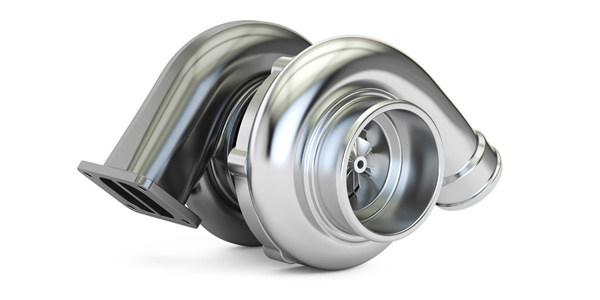Get This Report on Turbochargers
Table of ContentsTurbochargers - An Overview6 Simple Techniques For TurbochargersGet This Report on Turbochargers
Modern turbochargers can use wastegates, blow-off valves and variable geometry, as talked about in later areas. In gas engine turbocharger applications, boost pressure is limited to keep the entire engine system, including the turbocharger, inside its thermal and mechanical design operating variety (turbochargers). Over-boosting an engine often causes damage to the engine in a range of methods consisting of pre-ignition, overheating, and over-stressing the engine's internal hardware.Opening the wastegate enables the excess energy predestined for the turbine to bypass it and pass directly to the exhaust pipeline, hence lowering increase pressure. The wastegate can be either controlled manually (regularly seen in airplane) or by an actuator (in vehicle applications, it is typically controlled by the engine control unit).

The increased temperature level from the greater pressure gives a greater Carnot efficiency. A lowered density of intake air is triggered by the loss of climatic density seen with elevated elevations. Hence, a natural usage of the turbocharger is with airplane engines. As an airplane climbs up to higher elevations, the pressure of the surrounding air rapidly falls off.
In airplane engines, turbocharging is commonly used to keep manifold pressure as altitude increases (i. e. to compensate for lower-density air at greater altitudes). Since air pressure decreases as the aircraft climbs, power drops as a function of elevation in typically aspirated engines. Systems that utilize a turbocharger to keep an engine's sea-level power output are called turbo-normalized systems.

5 inHg (100 kPa). Turbocharger lag (turbo lag) is the time needed to alter power output in response to a throttle change, noticed as a hesitation or slowed when accelerating as compared to a naturally aspirated engine. This is due to the time required for the exhaust system and turbocharger to generate the required boost which can also be described as spooling.
The 7-Second Trick For Turbochargers
Superchargers do not suffer this problem, because the turbine is removed due to the compressor being straight powered by the engine. Turbocharger applications can be classified into those that need modifications in output power (such as automotive) and those that do not (such as marine, aircraft, business vehicle, commercial, engine-generators, and locomotives).
Engine creates lower lag in a variety of ways: Reducing the rotational inertia of the turbocharger by utilizing lower radius parts and ceramic and other lighter materials Changing the turbine's aspect ratio Increasing upper-deck air pressure click here to find out more (compressor discharge) and improving wastegate response Lowering bearing frictional losses, e. g., utilizing a foil bearing instead of a standard oil bearing Using variable-nozzle or twin-scroll turbochargers Decreasing the volume of the upper-deck piping Using numerous turbochargers sequentially or in parallel Using an antilag system Utilizing a turbocharger spindle valve to increase exhaust gas circulation speed to the (twin-scroll) turbine In some cases turbo lag is mistaken for engine speeds that are listed below increase threshold.
This wait on automobile speed increase is not turbo lag, it is inappropriate gear choice for increase demand. turbochargers. As soon as the vehicle reaches adequate speed to provide the required rpm to reach increase threshold, there will be a far shorter delay while the turbo itself constructs rotational energy and transitions to favorable increase, only this tail end of the hold-up in accomplishing favorable boost is the turbo lag.
Below a particular rate of circulation, a compressor produces irrelevant boost. This restricts boost at a specific RPM, despite exhaust gas pressure. More recent turbocharger and engine advancements have gradually lowered increase limits. Electrical improving (" E-boosting") is a brand-new straight from the source innovation under development. It utilizes an electric motor to bring the turbocharger up to operating speed quicker than possible utilizing available exhaust gases.

The operating speed (rpm) at which there is sufficient exhaust gas momentum to compress the air going into the engine is called the "increase threshold rpm". Lowering the "increase limit rpm" can enhance throttle reaction - turbochargers. The turbocharger has three primary parts: The turbine, which is generally a radial inflow turbine (however is generally a single-stage axial inflow turbine in large Diesel motor) The compressor, which is generally a centrifugal compressor The center housing/hub turning assembly Numerous turbocharger setups utilize additional technologies, such as wastegates, intercooling and blow-off valves.
Not known Incorrect Statements About Turbochargers
On the why not try these out right are the braided oil supply line and water coolant line connections. Compressor impeller side with the cover removed. Turbine side housing removed. Energy supplied for the turbine work is transformed from the enthalpy and kinetic energy of the gas. The turbine real estates direct the gas circulation through the turbine as it spins at as much as 250,000 rpm.
Frequently the very same fundamental turbocharger assembly is available from the producer with multiple housing options for the turbine, and sometimes the compressor cover also. This lets the balance between efficiency, reaction, and efficiency be tailored to the application. The turbine and impeller wheel sizes also dictate the amount of air or exhaust that can stream through the system, and the relative performance at which they operate.
Measurements and shapes can vary, along with curvature and number of blades on the wheels. A turbocharger's performance is closely connected to its size. Big turbochargers take more heat and pressure to spin the turbine, developing lag at low speed. Little turbochargers spin rapidly, however may not have the exact same efficiency at high velocity.